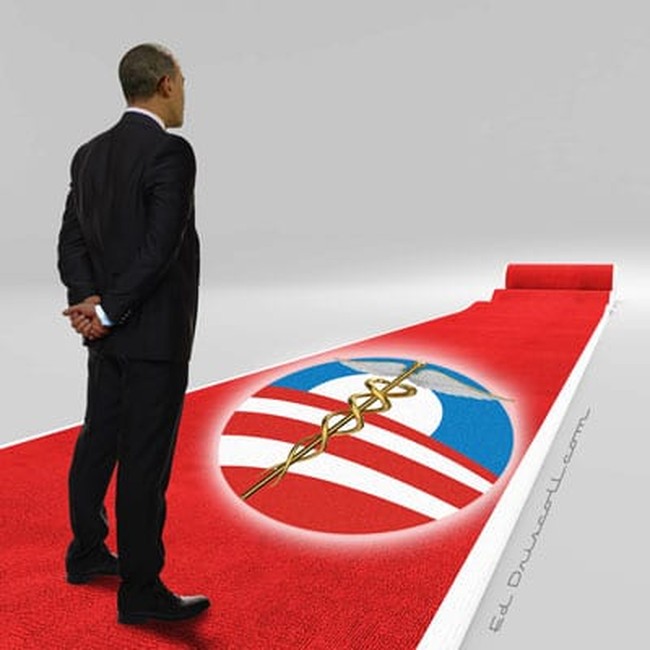This is the second in a series of articles on the rollout of Obamacare and how the law will change our health care system. Each week, we will publish two articles: one on the changes in medicine and medical care, and one on changes in the insurance industry. We hope this series of articles will help you make better decisions when it comes to your health care and how you buy insurance.
The Affordable Care Act (Obamacare) was passed in early 2010, but it will get its meaningful debut only in the next few months. The act was designed to make a significant dent in the number of Americans without health insurance. At the time the legislation was passed, the estimate of the number of uninsured Americans was 46.5 million, a number that had risen slightly after the financial crisis of 2008-2009.
The act anticipated providing coverage for approximately 30 million people, leaving close to 20 million uninsured by the middle of the decade. The bill assumed that the number of uninsured would rise without the legislation, to close to 50 million.
The number of uninsured is not a fixed number for a year — the same group of people are not uninsured for the full period of time. People lose their insurance, and others who were uninsured gain new insurance, sometimes through work. The total number of those uninsured for any time during a year is tens of millions higher than the 46.5 million number, and the number who are uninsured for the entire period during any 12-month cycle is tens of millions less than this number.
So, too, the composition of the uninsured population is quite varied. About a fifth earn $75,000 or more in annual income, a level well above the national median income for an individual or family unit. About 18 million, or near 40% of the uninsured, have incomes over $50,000, close to the median income level. Obamacare provides subsidies for those buying policies in the state exchanges with incomes between 138% of the poverty level and 400% of that level (now $94,000 for a family of four). The legislation also provides expanded coverage under the state Medicaid programs for those with incomes between 100% of the poverty level and 138% of that level, depending on family size.
At the time the legislation was passed, there were some estimates that over 10 million Americana qualified for Medicaid, Medicare, or some other government program even without the new legislation, but had never enrolled. It is, of course, possible that many newly eligible for Medicaid will not enroll despite the eligibility expansion under Obamacare.
Another sizable group of uninsured are illegal immigrants, estimated at five million or more. These individuals would not be eligible to participate in the exchanges under Obamacare, and would continue to be ineligible even under the Senate’s version of immigration reform. However, immigration-reform advocates are now pushing hard to get that provision changed. Even if they fail, the president has shown recently that he can change immigration policy by executive order.
Overall, the number of uninsured who were locked out of the insurance market because of denial of coverage or high-priced policies was only a fraction of the total uninsured population — probably less than 20% of the total uninsured, and less than 3% of all Americans.
Because this number was so small compared to the total population, the bill was sold as insuring coverage for 50 million Americans, even though 80% of this group, if not more, could already obtain insurance either through government programs or the insurance market. Many without insurance were simply unwilling to buy insurance.
That history of non-purchase decisions is a threat to the success of the Obamacare initiative, especially with regard to the new state exchanges. Those with incomes above the Medicaid eligibility limits can now purchase policies on the exchanges with guaranteed issue, and in many cases, with a partial subsidy from the federal government.
The big question: how many who have not bought policies in the past will choose to do so starting in October?
A second question: how many individuals now provided health insurance by corporations will soon find themselves needing to navigate the exchanges as a result of decisions made by their companies? Will their employers look to reduce their hours below 30 per week, or to terminate a corporate policy and dump all employees onto the exchanges?
The Obama administration recently announced that the employer mandate to provide health insurance for full-time workers (defined as those working over 30 hours per week) for companies with 50 or more employees would be waived for a year. As a result, the next year will be an opportunity for companies to move employees from company coverage to the exchanges, since the individual mandate to buy insurance is still scheduled to begin with the exchanges opening on October 1.
The exchanges will likely offer attractively priced policies for those with pre-existing conditions who were denied coverage, or for those who could only buy very expensive policies or were stuck in group insurance plans whose cost increased rapidly from year to year. This is also likely to be true of older individuals too young to qualify for Medicare who have seen their health insurance costs rise rapidly in the individual market.
Most of the uninsured are not older Americans.
Those aged 18 to 34 make up a disproportionate share of the uninsured market. Because of the limitations on insurance companies charging risk premiums for older individuals in the new Obamacare exchanges, younger Americans will be offered polices that are more costly and which result in a subsidy of the older insured who purchase insurance in the market. As a result, younger Americans’ lack of interest in buying health insurance could continue, especially since the penalty (or tax, as Justice Roberts defined it) for failure to buy coverage is comparably small. It starts at $100 the first year, and rises to about $700 in the third year.
The Supreme Court gave their seal of approval to Obamacare by a 5-4 margin in the Spring 2012 term. But Justice Roberts, who voted with the four liberal justices to uphold the mandate, was joined by six other justices in ruling that states could decide not to expand their Medicaid program under Obamacare without risk to the current Medicaid funding provided by the federal government for those earning below 100% of the poverty level.
This decision meant that the ability of the federal government to expand the Medicaid program was now dependent on the willingness of the states to expand their program. So far, only about half the states have elected to expand their programs, and some of the states with large Medicaid populations — such as Texas, Florida, Ohio, and Pennsylvania — have not signed on. Governors in some of those states support the expansion but have had trouble persuading their state legislatures to pass the required legislation. Michigan’s state Senate, after a contentious battle, voted this week to expand Medicaid through Obamacare.
Many governors see the Medicaid expansion as nearly free money: the expansion has a 100% federal support level for a few years before dropping to 90%, whereas the current Medicaid program is funded by a 50%-50% federal/state mix of support. Providers, especially hospitals, are excited about the program expansion, since it will replace non-paying patients with patients paid for by Medicaid. Even though Medicaid payment levels are generally considered inadequate and below the cost of care, they are still a lot higher than zero, which is what charity care or bad debts among the uninsured produce in revenue per patient.
In any case, if half of the expansion of care to the uninsured under Obamacare was going to come from the Medicaid program, it seems today very unlikely that the number of new enrollees will come anywhere close to 15 million. A number of about half of that may even be a stretch, given current levels of state buy-in. If the state participation rate stays low, then the cost of the Medicaid expansion will of course be lower than anticipated.
The dynamics at work on the exchanges is different. The designers of Obamacare counted on participation (purchase of policies on the exchanges) by enough younger people to help subsidize the cost of care for those who are older and sicker, and far more likely to buy insurance if offered the chance. Younger people use far fewer health care resources than older people (doctor visits, tests, inpatient stays, surgeries, etc.), so if only heavy consumers of care sign up, the policies will prove to be disastrous for the insurers. Many of whom will then abandon the markets. Already, many big health insurance carriers are choosing not to participate in the exchanges, since they expect their claims costs versus insurance premiums will be unsatisfactory.
The Obama administration has released the number of seven million as its first-year target for signups in the exchanges. This represents less than half of those eligible to sign up, not a very aggressive goal.
One of the most foolish provisions in the law was the low cost of the penalty for non-participation in the individual market (the penalty is higher per worker in the corporate market, but almost certainly too low there as well to incentivize participation). The easiest policy for many individuals will be to continue having no health insurance and to only buy coverage if something bad happens.
There is no reason at this point to expect a smooth rollout of the exchanges or of the new Medicaid coverage.
The president seems committed to spending the fall where he is most comfortable — on the stump, campaigning for people to give Obamacare a chance. Yet unlike his two presidential campaigns, so far Obama has never managed to move the needle positively regarding support for Obamacare.
—————————–
Also read Dr. Paul Hsieh’s “How Big Medicine Will Affect Patient Care“










Join the conversation as a VIP Member